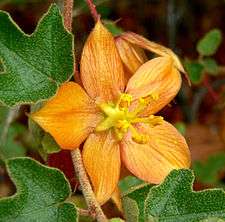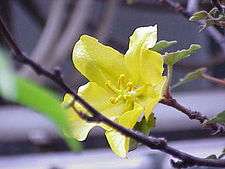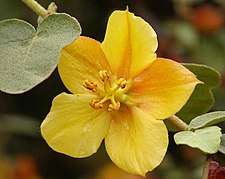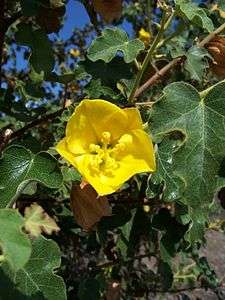Fremontodendron californicum
Fremontodendron californicum, with the common names California flannelbush, California fremontia, and flannel bush, is a flowering shrub native to diverse habitats in southwestern North America.[1]
| Fremontodendron californicum | |
|---|---|
 | |
| Scientific classification | |
| Kingdom: | Plantae |
| Clade: | Tracheophytes |
| Clade: | Angiosperms |
| Clade: | Eudicots |
| Clade: | Rosids |
| Order: | Malvales |
| Family: | Malvaceae |
| Genus: | Fremontodendron |
| Species: | F. californicum |
| Binomial name | |
| Fremontodendron californicum | |
 | |
| Natural range | |
| Synonyms | |
|
Fremontia californica Torr. | |
Distribution
Fremontodendron californicum is found in numerous habitats across California at elevations of 1,300–6,500 feet (400–1,980 m), especially California chaparral and woodlands, Yellow Pine Forests, and Pinyon-juniper woodlands along the eastern San Joaquin Valley.[2][3] It is found along the eastern San Joaquin Valley in the western foothills of the Sierra Nevada in chalky, sandy, nutritionally poor soils; on the east slope Cascade Range foothills of the northwest Sacramento Valley and the Klamath Mountains to the west; the California Coast Ranges throughout the state; the Transverse Ranges, and the Peninsular Ranges.[2][3]
It is also found in small, isolated populations in the mountains of central and western Arizona, in the Arizona transition zone-Mogollon Rim region, primarily in the Mazatzal Mountains and Superstition Mountains.[4] It is also found from central to northern Baja California state, in isolated chaparral locales in the Peninsular Ranges.[3]
Description
The plant is a flowering evergreen hardwood shrub or small multi-trunked tree, growing from 8–18 feet (2.4–5.5 m) in height and 6–10 feet (1.8–3.0 m) in width.
The 1–5 centimetres (0.39–1.97 in) leaves are olive to gray−green, fuzzy and flannel-like, palmately to pinnately lobed. The hairs covering the leaves are easily brushed off in human contact, and can be a skin and eye irritant.
The large flowers are 3.5–6.0 centimetres (1.4–2.4 in) in diameter, a rich yellow, sometimes with orange, coppery, or reddish margins. They blossoms are borne in great showy masses, and tend to bloom one at a time. Each petal has an attractive, curved shape that comes to a point.
Taxonomy
Fremontodendron californicum is one of three species in the genus Fremontodendron, the others being Fremontodendron mexicanum and Fremontodendron decumbens.[5][6]
Former subspecies

Subspecies have formerly included:
- Fremontodendron californicum ssp. decumbens [7] — Pine Hill flannelbush: reclassified as Fremontodendron decumbens (R. Lloyd).[8][9][10]
- A decumbent and low spreading form, 3 feet (0.91 m) in height and 6 feet (1.8 m) in width, has yellow-orange flowers, and is endemic to the Sierra Nevada foothills, nearly all of the individuals of this subspecies are found in the Pine Hill Ecological Reserve in El Dorado County. In nature it only grows in metal-rich gabbro soil, a red weathered soil of volcanic origin. It requires fire for seed germination, but as the nature reserve is near human settlements fire ecology is suppressed. It is a federally listed endangered species.

- Fremontodendron californicum ssp. californicum — California fremontia: now reclassified as the species, Fremontodendron californicum.[11]
- Fremontodendron californicum ssp. napensis — Napa Fremontia: The current Jepson does not recognize this subspecies, using Fremontodendron californicum, but the form is different enough that it is horticulturally recognized by this name. It is typically smaller and more open in form than the species, with much smaller leaves and flowers. It grows 6–15 feet (1.8–4.6 m) in height and 4–12 feet (1.2–3.7 m) in width.[12]
Uses
Medicinal
As a traditional Native American medicinal plant, the inner bark's sap that was used as a topical remedy for mucous membrane irritation and for gastrointestinal upset, by some of the indigenous peoples of California.[13] The wood was also used by the Californian Yokut and Kawaiisu peoples as a building and furniture material, and the bark for cordage and for nets used in acorn cache holding and snare hunting.[13]
Cultivation
Fremontodendron californicum is cultivated as an ornamental plant by specialty plant nurseries, for planting in native plant, drought tolerant, and wildlife gardens, and in natural landscaping and habitat restoration projects.[14][15]
Cultivated plants need good drainage, and no supplemental summer water when established. Fremontodendron californicum ssp. decumbens is the most garden tolerant of all Fremontia, and can also be used in large pots and planters.[16]

Hybrids
There are several named hybrids of Fremontodendron californicum and F. mexicanum in the horticultural trade, they include:
- Fremontodendron 'California Glory' — lemon-yellow flowers with a reddish tinge, grows 20 feet (6.1 m) in height by 20 feet (6.1 m) in width. It is the winner of the Award of Garden Merit from the California Horticultural Society in 1965, and received a First Class Certificate from the Royal Horticultural Society in 1967.[17]
- Fremontodendron 'Ken Taylor' — golden flowers with a darker orange outside petals in the spring and summer, and grows to only 5 feet (1.5 m) in height by 8–10 feet (2.4–3.0 m) in width.[18]
- Fremontodendron 'Dara's Gold' — golden flowers over a long period from late winter through early summer, grows 3 feet (0.91 m) in height by 6–8 feet (1.8–2.4 m) in width. A hybrid between Fremontodendron decumbens and Fremontodendron mexicanum.[19]
- Fremontodendron 'San Gabriel' — 10–18 feet (3.0–5.5 m) in height by 8–12 feet (2.4–3.7 m) in width, suitable for an espalier.[20]
Etymology
Fremontodendron is named for Major General John Charles Frémont (1813–90), an explorer of western North America. Californicum means 'from California'.[21]
References
- ITIS Standard Report Page: Fremontodendron californicum . accessed 2.28.2015
- Jepson eFlora: Distribution
- Little. Atlas of United States Trees, Volume 3, Minor Western Hardwoods, Little, Elbert L, 1976, US Government Printing Office. Library of Congress No. 79-653298. Map 84,
- ASU.edu: Fremontodendron californicum
- USDA PLANTS: Classification of Fremontia . accessed 2.28.2015
- CalFlora Database: : Species of genus Fremontia . accessed 2.28.2015
- Calflora: Fremontodendron californicum ssp. decumbens (JM93)
- Calflora: Fremontodendron decumbens . accessed 2.28.2015
- USDA Plants Profile for Fremontodendron decumbens (Pine Hill flannelbush) . accessed 2.28.2015
- Jepson eFlora: Fremontodendron decumbens . accessed 2.28.2015
- Calflora: Fremontodendron californicum ssp. californicum
- Theodore Payne Foundation, California Natives Wiki: Fremontodendron californica ssp. napense (Napa Fremontia)
- University of Michigan,Dearborn: Native American Ethnobotany
- Las Pilitas Horticultural Database: Fremontodendron californicum (California Flannel Bush)
- Bornstein, Carol, David Fross, and Bart O'Brien. California Native Plants for the Garden. Los Olivos, CA: Cachuma Press. 2005.
- Theodore Payne Foundation, California Natives Wiki: Fremontodendron decumbens
- San Marcos Growers: Fremontodendron 'California Glory'
- San Marcos Growers: Fremontodendron 'Ken Taylor'
- San Marcos Growers: Fremontodendron 'Dara's Gold'
- Theodore Payne Foundation, Horticulture Wiki: Fremontodendron 'San Gabriel' (San Gabriel flannel bush)
- Gledhill, David (2008). "The Names of Plants". Cambridge University Press. ISBN 9780521866453 (hardback), ISBN 9780521685535 (paperback). pp 84, 171

External links
- USDA Plants Profile for Fremontodendron californicum (California flannelbush)
- Jepson Manual Treatment of Fremontodendron californicum
- Calflora Database: Fremontodendron californicum (California flannelbush, California fremontia, Flannel bush)
- Fremontodendron californicum — UC Photo gallery
- Lady Bird Johnson Wildflower database + gallery
| Wikimedia Commons has media related to Fremontodendron californicum. |
